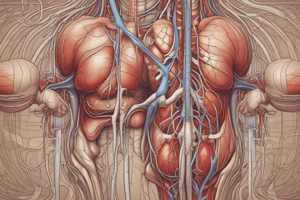Podcast
Questions and Answers
What is the approximate length of the female urethra?
What is the approximate length of the female urethra?
- 8-10 cm
- 6-8 cm
- 2-4 cm
- 4-6 cm (correct)
What supplies blood to the female urethra?
What supplies blood to the female urethra?
- Aorta
- Internal pudendal and vaginal arteries (correct)
- Femoral artery
- External iliac artery
What is the darker inner region of the kidney?
What is the darker inner region of the kidney?
- Cortex
- Renal papilla
- Renal pyramid
- Medulla (correct)
How many conical regions are found in the medulla?
How many conical regions are found in the medulla?
What is the function of the smooth muscle in the calyces, pelvis, and ureters?
What is the function of the smooth muscle in the calyces, pelvis, and ureters?
Approximately how many nephrons are found in each kidney?
Approximately how many nephrons are found in each kidney?
What is the main function of the kidneys in the renal system?
What is the main function of the kidneys in the renal system?
What is the shape of the bladder?
What is the shape of the bladder?
What is the function of the detrusor muscle in the bladder?
What is the function of the detrusor muscle in the bladder?
How much urine can the bladder normally hold?
How much urine can the bladder normally hold?
What is the length of the male urethra?
What is the length of the male urethra?
What is the function of the ring-like muscle around the opening of the urethra?
What is the function of the ring-like muscle around the opening of the urethra?
What is the nerve supply of the male urethra?
What is the nerve supply of the male urethra?
Which blood vessels drain blood from the bladder arteries in females?
Which blood vessels drain blood from the bladder arteries in females?
Flashcards are hidden until you start studying
Study Notes
Structure of Renal System
- The renal system consists of kidneys, ureters, bladder, and urethra, involved in forming and releasing urine.
- The kidneys are bean-shaped organs that produce urine to eliminate waste substances.
- Tubes called ureters transport urine from the kidneys to the urinary bladder.
Kidneys
- The kidney has a pale outer region called the cortex and a darker inner region called the medulla.
- The medulla is divided into 8-18 conical regions called renal pyramids, which merge to form the renal pelvis and then the ureter.
- Each kidney contains about 1.3 million nephrons, the functional units of the kidney.
- The cortex and medulla are made up of nephrons.
Bladder
- The bladder is a pyramid-shaped organ that sits in the pelvis and stores urine.
- The bladder can hold up to 500 mL of urine.
- The bladder has three openings: two for the ureters and one for the urethra.
- The bladder consists of smooth muscles, with the main muscle being the detrusor muscle.
- Muscle fibers around the opening of the urethra form a ring-like muscle that controls the passage of urine.
- The blood supply of the bladder is from multiple blood vessels, including the vesical arteries, obturator, uterine, gluteal, and vaginal arteries.
- In females, a venous network drains blood from the bladder arteries into the internal iliac vein.
Urethra
- The male urethra is 18-20 cm long, running from the bladder to the tip of the penis.
- The male urethra is supplied by the inferior vesical and middle rectal arteries.
- The nerve supply of the male urethra is via the pudendal nerve.
- The female urethra is 4-6 cm long and 6 mm wide, running from the bladder neck to the top of the vaginal opening.
- The female urethra is supplied by the internal pudendal and vaginal arteries.
- The female urethra is shorter than the male urethra, making it more prone to infections from bacteria in the vagina.
Studying That Suits You
Use AI to generate personalized quizzes and flashcards to suit your learning preferences.




